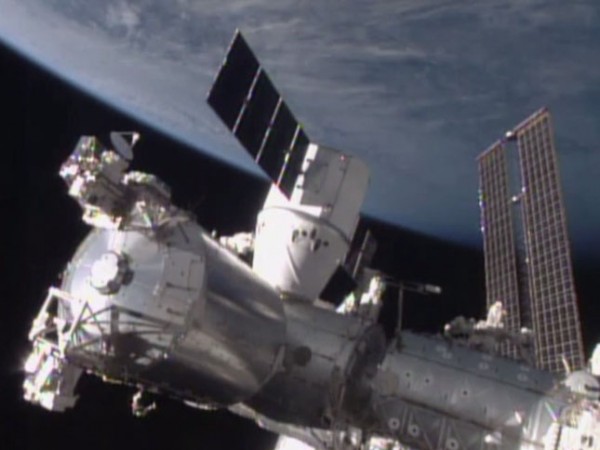
The privately owned SpaceX Dragon cargo spacecraft docked with the Harmony module of the International Space Station (ISS) at 8:54 a.m. EST (1354 UTC) today (January 12, 2015). ISS commander Butch Wilmore used a robot arm to grab the capsule and its 5,000 pounds (2,300 kg) of precious cargo, consisting of needed supplies and science experiments. The hatch between the newly arrived spacecraft and the Harmony module of the space station is scheduled to be opened Tuesday, but could be opened earlier, according to NASA. Today’s docking marks the successful completion SpaceX’s main mission, although an earlier phase of the mission – in which a portion of the launch vehicle tried to make a soft landing on a floating sea platform this past weekend – did not work as planned.
The six astronauts aboard ISS are glad to see the SpaceX capsule. They are said to be running low on supplies after a previous U.S. supply ship – owned by Orbital Sciences – was destroyed in an explosion shortly after launch in October.
Th SpaceX capsule is scheduled to spend four weeks attached to ISS.

On Saturday (January 10), SpaceX successfully launched its craft following several weeks of delays, most recently on January 6.
Part of the goal on launch day was to fly the first stage of SpaceX’s Falcon rocket back to a drone ship sitting 200 miles (300 km) off the coast of Cape Canaveral in Florida, and soft land the huge piece of the rocket at sea. This “experiment,” as SpaceX called it, was part of SpaceX’s attempt to lower the cost of space missions.
However, Elon Musk, CEO of SpaceX, tweeted that the booster had hit the platform hard and had been lost. He later said that aerodynamic fins on the rocket had run out of hydraulic fluid just before landing. He said:
Close, but no cigar.
Bodes well for the future tho’. Ship itself is fine. Some of the support equipment on the deck will need to be replaced.
The company said it will keep working on the technology that would allow them to recover, refurbish and re-use rockets that normally would be disposable.
Bottom line: SpaceX Dragon cargo spacecraft docked with the Harmony module of the International Space Station on January 12, 2015 at 8:54 a.m. EST (1354 UTC).











